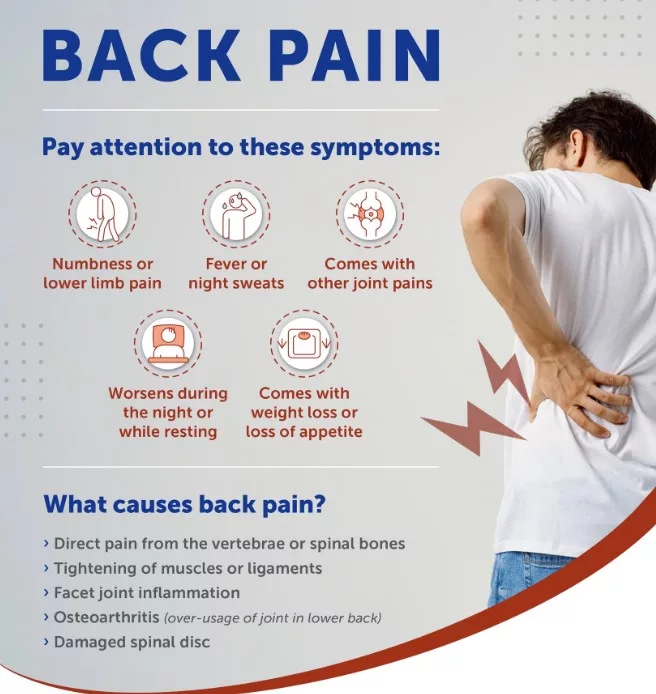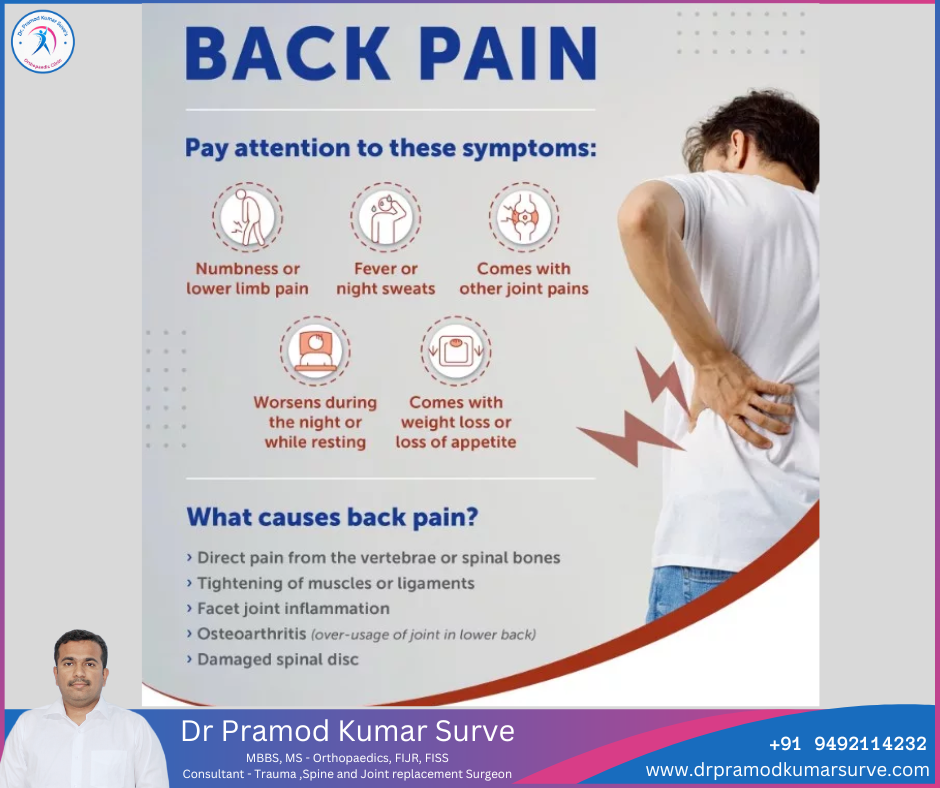Low back pain is a common and often debilitating condition that can affect people of all ages and backgrounds. Whether it’s a dull, nagging ache or a sharp, intense pain, low back pain can significantly impact your quality of life. In this blog post, we will explore the various aspects of low back pain, from its causes and symptoms to prevention and treatment options. Whether you’re currently suffering from low back pain or simply interested in learning more about it, this comprehensive guide aims to provide you with the knowledge and insights you need.
TYPES OF LOW BACK PAIN

Low back pain can manifest in various forms and be categorized based on its characteristics and underlying causes. Understanding the types of low back pain is essential for accurate diagnosis and effective treatment. Here are some common types:
- Mechanical Low Back Pain:
- Acute Mechanical Low Back Pain: This type of pain is typically caused by sudden trauma or strain, such as lifting a heavy object improperly or overexertion during physical activity. It is usually short-lived and may resolve with rest and self-care.
- Chronic Mechanical Low Back Pain: Chronic mechanical low back pain results from ongoing wear and tear on the spine or muscles. It can be associated with muscle imbalances, poor posture, or repeated microtrauma. This type of pain lasts for 12 weeks or longer.
- Radicular Pain (Sciatica): Radicular pain occurs when a spinal nerve root is compressed, leading to pain that radiates along the nerve’s path. Sciatica is a common form of radicular pain, characterized by sharp, shooting pain that travels down one leg. It is often caused by a herniated disc or spinal stenosis.
- Referred Pain: Referred pain is discomfort that is felt in the lower back but originates from a different location, such as the internal organs. For example, kidney stones or infections may cause referred pain in the lower back.
- Degenerative Disc Disease: This condition is not a disease but rather a natural part of aging. Over time, the intervertebral discs that cushion the spine can lose their elasticity and become less effective at absorbing shock. This can lead to chronic, dull low back pain.
- Spinal Stenosis: Spinal stenosis is a condition characterized by the narrowing of the spinal canal. This can put pressure on the spinal cord and nerves, causing pain, numbness, and weakness in the lower back and legs. Spinal stenosis may be caused by age-related changes in the spine or by structural abnormalities.
- Ankylosing Spondylitis: Ankylosing spondylitis is a form of inflammatory arthritis that primarily affects the spine, causing stiffness and pain. It typically begins in the sacroiliac joints (located at the base of the spine) and can lead to chronic low back pain.
- Fibromyalgia: Fibromyalgia is a chronic condition characterized by widespread pain and tenderness in the muscles, ligaments, and tendons. Low back pain is a common symptom for individuals with fibromyalgia.
- Spondylolisthesis: This condition occurs when one vertebra slips forward over the one below it. It can cause lower back pain and may also lead to nerve compression.
- Piriformis Syndrome: The piriformis is a small muscle in the buttocks. When it becomes tight or spasms, it can compress the sciatic nerve and result in symptoms similar to sciatica.
- Muscle Imbalance or Weakness: Imbalances in the muscles supporting the spine, including the core muscles, can lead to low back pain. These imbalances can result from poor posture, sedentary lifestyles, or previous injuries.
It’s important to note that an individual may experience a combination of these types of low back pain, and the specific diagnosis can vary from person to person. Accurate diagnosis by a healthcare professional is critical to tailor treatment and management strategies effectively. The treatment approach for low back pain depends on its cause and may include physical therapy, medication, exercise, and, in some cases, surgery.
SYMPTOMS OF LOW BACK PAIN

Low back pain can present with a variety of symptoms, and the specific manifestations may vary depending on the underlying cause and individual factors. Here are some common symptoms associated with low back pain:
- Dull or Aching Pain: Many individuals with low back pain experience a persistent, dull, or aching discomfort in the lower back region. This pain can range from mild to severe and may be constant or intermittent.
- Radiating Pain (Sciatica): Sciatica is a common symptom of low back pain that occurs when the sciatic nerve, which runs from the lower back down the legs, is compressed or irritated. This can result in sharp, shooting pain that radiates down one or both legs.
- Muscle Spasms: Low back pain often leads to muscle spasms or cramping in the lower back. These spasms can contribute to additional discomfort and stiffness.
- Reduced Flexibility: Low back pain can limit a person’s range of motion, making it difficult to bend, twist, or move freely. This reduced flexibility can be especially noticeable when attempting activities that involve the lower back.
- Difficulty Standing Up Straight: Some individuals with low back pain may find it challenging to maintain an upright posture, causing them to hunch forward or lean to one side.
- Numbness or Tingling: When low back pain is associated with nerve compression, such as in cases of herniated discs or spinal stenosis, numbness or tingling sensations may occur in the lower back, buttocks, or legs.
- Weakness: Muscular weakness, particularly in the legs, can be a symptom of low back pain, especially if it’s related to nerve compression. Weakness may affect mobility and coordination.
- Pain Aggravated by Certain Activities: Low back pain may worsen with specific activities, such as lifting heavy objects, prolonged sitting or standing, bending, or twisting. The pain may be more noticeable during or after these activities.
- Pain Relief with Rest: In cases of acute low back pain, rest and a change in activity may provide relief. Individuals with muscle strains or minor injuries may find that pain subsides with rest.
- Chronic Pain: Chronic low back pain, which persists for 12 weeks or longer, is often characterized by ongoing discomfort. This pain can be relatively consistent or may have periods of exacerbation and improvement.
- Painful Mornings: Some individuals with low back pain report increased discomfort in the morning, which may improve as they become more active throughout the day.
- Pain During Certain Movements: Low back pain can be triggered or exacerbated by specific movements, such as bending forward, lifting, or twisting. These movements may place added stress on the lower back.
